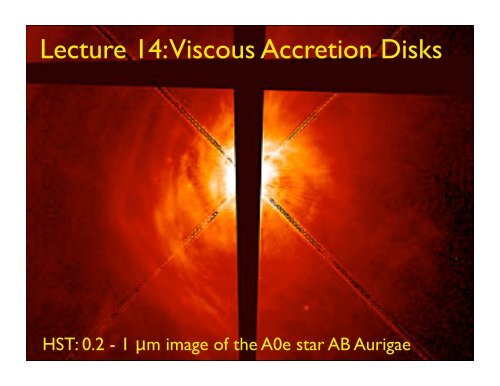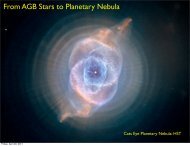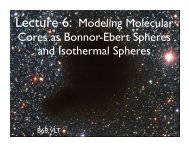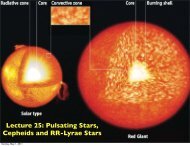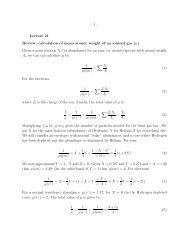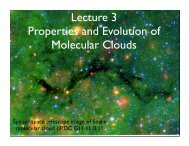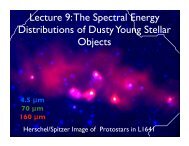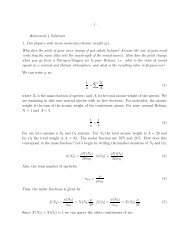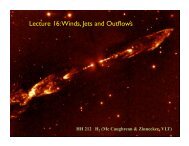Lecture 14: Viscous Accretion Disks
Lecture 14: Viscous Accretion Disks
Lecture 14: Viscous Accretion Disks
- No tags were found...
You also want an ePaper? Increase the reach of your titles
YUMPU automatically turns print PDFs into web optimized ePapers that Google loves.
OB Associations as Laboratories for Disk EvolutionHernandez et al. 2008OB1b: 5 Myr
OB Associations as Laboratories for Disk EvolutionHernandez et al. 2008OB1a: 10 Myr
OB Associations as Laboratories for Disk EvolutionCalvet et al. 2005
The formation of a diskshockshock• Infalling matter collides with matter from the other side• Forms a shock• Free-fall kinetic energy is converted into heat€kT≈ 1µ m v 2 2 ff= GM *pr• Heat is radiated away, matter cools, sediments to midplane• Disk is formed€At 10 AU from 1M star:T ≈ 25000K
The formation of a disk3-D Radiation-Hydro simulations of disk formationYorke, Bodenheimer & Laughlin 1993
Keplerian rotation (a reminder)Disk material is almost (!) 100% supported against gravityby its rotation. Gas pressure plays only a minor role.Therefore it is a good approximation to say that thetangential velocity of the gas in the disk is:v φ≅ Ω Kr = GM *rΩ K≡ GM *r 3Kepler frequency€€
The angular momentum problem• Angular momentum of 1 M in 10 AU disk:3x10 53 cm 2 /s• Angular momentum of 1 M in 1 R star:
Outward angular momentum transportRing A moves faster than ringB. Friction between the twowill try to slow down A andspeed up B. This means:angular momentum istransferred from A to B.Specific angular momentumfor a Keplerian disk:AB€l = rv φ= r 2 Ω K=GM *rSo if ring A looses angular momentum, but is forced toremain on a Kepler orbit, it must move inward! Ring B movesoutward, unless it, too, has friction (with a ring C, which hasfriction with D, etc.).
Non-stationary (spreading) disksTime steps of 2x10 5yearLynden-Bell & Pringle (1974), Hartmann et al. (1998)
Formation & viscous spreading of disk
Formation & viscous spreading of disk
Formation & viscous spreading of disk
Formation & viscous spreading of diskFrom the rotating collapsing cloud model we know:r centrif~ t 4Initially the disk spreads faster than the centrifugal radius.Later the centrifugal € radius increases faster than diskspreading
Formation & viscous spreading of diskA numerical model
Formation & viscous spreading of diskA numerical model
Formation & viscous spreading of diskA numerical model
Formation & viscous spreading of diskA numerical model
Formation & viscous spreading of diskA numerical model
ViscosityyAux
Viscosity
Shakura & Sunyaev modelRadial structureDefine the surface density:Σ(r) ≡∫+∞−∞ρ(r,z) dzIntegrate continuity equation over z:Difficulty: re-expressequations in cylindricalcoordinates. Complex due tocovariant derivatives oftensors... You’ll have tosimply believe the EquationsI write here...€∂Σ∂t + 1 ∂(Σrv r)= 0r ∂rIntegrate radial momentum equation over z:∂(Σv r)+ 1 ∂(Σrv 2 r)+ ∂(Σc 2 s)− Σ v 2φ GM= −Σ€ ∂t r ∂r ∂r r r 2Integrate tangential momentum equation over z:€∂(Σl)∂t+ 1 r∂(Σr v rl)∂r= 1 r∂ ⎛⎛∂r Σν ∂Ω⎞⎞⎜⎜⎝⎝r3 ⎟⎟∂r ⎠⎠€€(1)(2)( l ≡ v φr)(Ω ≡ v φ/r)(3)
Shakura & Sunyaev modelLet’s first look closer at the radial momentum equation:∂(Σv r)∂t+ 1 r∂(Σrv r 2 )∂r+ ∂(Σc 2 s)∂r− Σ v 2φr= −ΣGMr 2(2)Let us take the Ansatz (which one can later verify to be true)that v r
Shakura & Sunyaev modelLet’s now look closer at the tangential momentum equation:€ €∂(Σl ∂(Σl)rl)K)⎛⎛∂t⎞⎞+ 1 ∂(Σr v rl K)= 1 ∂ ⎛⎛⎜⎜⎝⎝⎟⎟∂t r ∂r r ∂r Σν ∂Ω K⎞⎞⎜⎜ r3 ⎟⎟⎝⎝ ∂r ∂r⎠⎠⎠⎠Now use continuity equation∂(Ω ∂lΣv Σv Kr∂r Kr 2 )r= 1 ∂r r∂⎛⎛∂r Σν ∂Ω K⎞⎞⎜⎜ r3 ⎟⎟⎝⎝ ∂r⎠⎠€∂Σ∂t + 1 ∂(Σrv r)r ∂r= 0(3)l K≡ Ω Kr 2The derivatives of the Kepler frequency can be worked out:€€€∂ GM *r∂r= 1 2GM *rv r= − 3Σ r= 1 2 Ω Kr∂ ∂∂r Σν ∂r( )GM r *= − 3r 3 2€GM *Ω= − 3 Kr 5 2rThat means: from the tangential momentum equationfollows the radial velocity €€
Radial structureShakura & Sunyaev modelOur radial structure equations have now reduced to:∂Σ∂t + 1 r∂(Σrv r)∂r= 0withv r= − 3Σ r∂(∂r Σν r )Missing piece: what is the value of ν?€It is not really known what value € ν has. This depends on thedetails of the source of viscosity. But from dimensionalanalysis it must be something like:ν = αc shα = 0.001...0.1Alpha-viscosity (Shakura & Sunyaev 1973)€€
Shakura & Sunyaev modelFurther on alpha-viscosity:€ν = αc shHere the vertical structure comes back into the radialstructure equations!h =kTr 3µm pGM *So we obtain for the viscosity:≡ c sΩ K€€ν = α c 2sΩ K€
Shakura & Sunyaev modelSummary of radial structure equations:∂Σ∂t + 1 r∂(Σrv r)∂r= 0€€v r= − 3Σ rν = α c 2sΩ K∂(∂r Σν r )If we know the temperature everywhere, we can readily solve theseequations (time-dependent or stationary, whatever we like).€€c s2If we don’t know the temperature a-priori, then we need to solve the above 3equations simultaneously with energy equation.
Shakura & Sunyaev modelSuppose we know thatis a given power-law:Ansatz: surface density is also a powerlaw:c s2c 2 s~ r −ξ€ν ≡ α c 2s −ξ +3 / 2~ rΩ K€Σ ~ r −ηThe radial velocity then becomes:€v€= 3(ξ + η − 2) ν r≡ − 3 ∂(Σ r ∂r Σν r ) €rStationary continuity equation:∂(Σrv r)= 0€ ∂rfrom which follows:Σ ~ r ξ −3 / 2 η = −ξ + 3/2Proportionality € constants are straightforward from here on...€v r= − 3 2νr
Examples:Shakura & Sunyaev modelT ~ r −3 / 2 €Σ ~ r −0€
Examples:Shakura & Sunyaev modelT ~ r −1 €Σ ~ r −1/ 2€
Examples:Shakura & Sunyaev modelT ~ r −1/ 2 €Σ ~ r −1€
Examples:Shakura & Sunyaev modelT ~ r −0 €Σ ~ r −3 / 2€
Shakura & Sunyaev modelFormulation in terms of accretion rate<strong>Accretion</strong> rate M ˙ is amount of matter per second thatmoves radially inward throught he disk.M ˙ = −2π rv rΣ€Working this out with previous formulae:€We finally obtain: €€˙ M = 3πν ΣM ˙ = 3πα c sΣΩ KΣ =2M ˙ Ω Kµ m p3πα k T mid€v r= − 3 2νrν ≡ α c 2sΩ K€ (but see later for morecorrect formula with innerBC satisfied)
Shakura & Sunyaev modelEffect of inner boundary condition:Powerlaw does not go all the way to the star. At inner edge(for instance the stellar surface) there is an abrupt deviationfrom Keplerian rotation. This affects the structure of the diskout to many stellar radii:Σ =M ˙ Ω Kµ m p3πα k T mid⎡⎡ ⎛⎛1− r in⎢⎢ ⎜⎜⎣⎣ ⎝⎝ r⎞⎞⎟⎟⎠⎠1/ 2⎤⎤⎥⎥⎦⎦Keep this in mind whenapplying the theory!
Shakura & Sunyaev modelHow do we determine the temperature?We must go back to the vertical structure......and the energyequation.....First the energy equation: heat production through friction:⎛⎛Q +≡ Σν r ∂Ω ⎞⎞K⎜⎜ ⎟⎟⎝⎝ ∂r ⎠⎠2= 9 4 Σν GM *r 3For power-law solution: use equation of previous page:v r= − 3 ν€2 r€ν = − 2 3 rv rThe viscous heat production becomes:€Q += − 34π €2πΣrv rGM *r 3
Shakura & Sunyaev modelHow do we determine the temperature?Q += − 34π 2πΣrv rGM *r 3Define ‘accretion rate’ (amount of matter flowing through thedisk per second):€M ˙ ≡ −2π Σr v r= constantEnd-result for the viscous heat production:€Q += 34π ˙ M Ω K2€
Shakura & Sunyaev modelHow do we determine the temperature?Now, this heat must be radiated away.Disk has two sides, each assumed to radiate as black body:One obtains:2σ T 4 eff= Q +⎛⎛ 3T eff= ˙ 2⎞⎞⎜⎜ M Ω K ⎟⎟€ ⎝⎝ 8πσ ⎠⎠€1/ 4= 34π ˙ M Ω K2~ r −3 / 4€€
Molecular viscosity? No!Problem: molecular viscosity is virtually zeroReynolds numberMolecular viscosity:Re = u LνTypical disk (at 1 AU): € N=1x10 <strong>14</strong> cm -3 , T=500 K, L=0.01AUAssume (extremely€simplified) σ H 2 ≈ π(1Ang)2 .u T= 3kTµm p= 2.3 km/sν = 7.3 ×10 6 cm 2 /sl free= 1Nσ= 32 cmRe = 4.7 ×10 9 L= length scale= typical velocityν = viscosityν = u Tl freel free = m.f.p. of molecule= velo of molecule€€€€
Magneto-rotational instability (MRI)(Also often called Balbus-Hawley instability)Highly simplified pictographic explanation:If a (weak) pull exists betweentwo gas-parcels A and B onadjacent orbits, the effect is thatA moves inward and B movesoutward: a pull causes them tomove apart!ABThe lower orbit of A causes anincrease in its velocity, while Bdecelerates. This enhances theirvelocity difference! This ispositive feedback: an instability.ACauses turbulence in the diskB
Magneto-rotational instability (MRI)Johansen & Klahr (2005); Brandenburg et al.
Gravitational (in)stabilityIf disk surface density exceeds a certain limit, then diskbecomes gravitationally unstable.Toomre Q-parameter:Q = h Ω 2Kπ GΣ≈ h rM *M diskFor Q>2 the disk is stableFor Q
Gravitational (in)stabilitySpiral waves actas `viscosity’Rice & Armitage
FU Orionis stars
McNeal’s Nebula: a new FU Ori?
Dunham et al. 2010TheLuminosityProblemGrey gives predictedluminosites frommodelsDunham et al. 2010This is a longstanding problem:the required accretionluminosities are on averagehigher than the observedluminosities.
Voroboyov &Basu
Summary• In Keplerian orbits, the inner disk is rotating fasterthan the outer disk• Viscosity acts as a friction. Mass is transportedinward, angular momentum outward.• This causes mass to accrete onto the central source(Will Fischer’s lecture tuesday), and the disk tospread outward.• Viscosity can be do to thermal motions in a gas (notimportant for disks), magneto rotational instability, orspiral waves created by gravity.• Young stars may go through episodic accretion: gasfirst accumulates onto a disk until it undergoesgravitational instability, then the mass is dumped ontothe disk in a major event.


